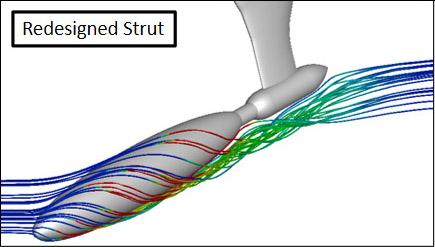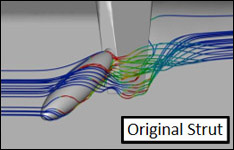Impact Statements

ONR HIPRO Experimental Design
 Success Story - Navy
Success Story - Navy
Attribution: NAVSEA and Office of Navy Research (ONR)

Velocity streamlines colored by vorticity magnitude (predicted by CREATE™-AV Kestrel) show less interference for redesigned HIPRO strut.
 PROBLEM
PROBLEM
The ONR-funded High-Reynolds Number Prolate Spheroid (HIPRO) program seeks to conduct high-fidelity measurements of the 6:1 prolate spheroid at the Large Cavitation Channel (LCC) in Memphis, Tennessee. Due to the sensitivity of the measurements involved, it is preferable that the experimental support apparatus has minimal impact on the quantities of interest (e.g. flow streamlines, surface pressures, etc.). Inclusion of the strut in the simulation will allow for error estimates accounting for strut interference. Additionally, this model will allow for prediction of the forces that will be experienced by the experimental rig under designed flow conditions in the LCC, informing safety tolerances for the tests.

Predicted streamlines show significant strut interference for original HIPRO strut design.
 SOLUTION
SOLUTION
The DoD HPCMP CREATE™-AV Kestrel CFD tool was used to simulate the free-floating prolate spheroid and the spheroid in a simulated LCC test tunnel with a modeled support strut. Multiple strut configurations, pitch angles, and sting lengths were simulated. By comparing results among this test matrix, it was possible to quantify the interference due to confinement/blockage and the presence of the support structure.
 IMPACT
IMPACT
CFD results indicated that the design of the original support strut introduced significant interference in measurements on the spheroid. The support structure was redesigned and the CFD analysis was repeated, indicating that the revised strut design produced much less interference and better comparison with the free-floating spheroid.
Distribution A: Approved for Public release; distribution is unlimited.
